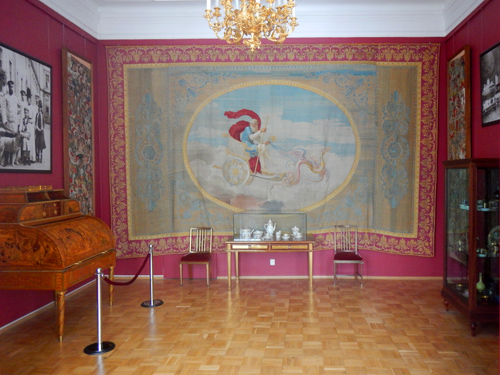Alexander’s Reception Rooms

There were four state reception rooms in the Gatchina Palace, where Alexander III received delegations of nobles, foreign ambassadors, ministers, and dignitaries. The officials travelled to Gatchina by a special train. There were rooms assigned to them in the Kitchen Wing so that they could tidy themselves up before the tsar’s audience.
Located on the second floor of the Arsenal Wing, the reception rooms were quite modestly decorated. All the furnishings including the furniture, tapestries, seventeenth and eighteenth century embroideries, and valuable porcelain were selected as the emperor’s personal tastes dictated. There were simple-looking sofas and chairs in leather upholstery installed beside the vintage carved wardrobes. The pictures were mostly by Russian painters from the late nineteenth century such as V.D. Orlovsky, K.P. Beggrov, A.P. Bogolyubov, I.N. Kramskoy, G.G. Myasoedov.
Most of the furnishings from the reception rooms have survived the war. The artworks that were largely unscathed include paintings, porcelain, and decorative bronze pieces.
See on interactive plan

There were four state reception rooms in the Gatchina Palace, where Alexander III received delegations of nobles, foreign ambassadors, ministers, and dignitaries. The officials travelled to Gatchina by a special train. There were rooms assigned to them in the Kitchen Wing so that they could tidy themselves up before the tsar’s audience.
Located on the second floor of the Arsenal Wing, the reception rooms were quite modestly decorated. All the furnishings including the furniture, tapestries, seventeenth and eighteenth century embroideries, and valuable porcelain were selected as the emperor’s personal tastes dictated. There were simple-looking sofas and chairs in leather upholstery installed beside the vintage carved wardrobes. The pictures were mostly by Russian painters from the late nineteenth century such as V.D. Orlovsky, K.P. Beggrov, A.P. Bogolyubov, I.N. Kramskoy, G.G. Myasoedov.
Most of the furnishings from the reception rooms have survived the war. The artworks that were largely unscathed include paintings, porcelain, and decorative bronze pieces.
See on interactive plan
